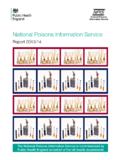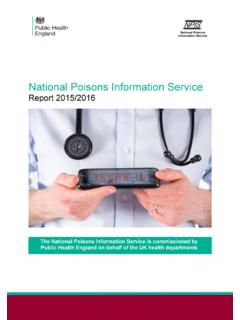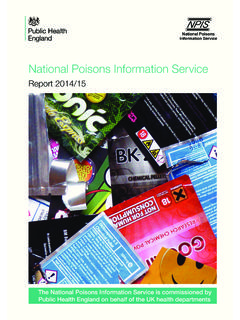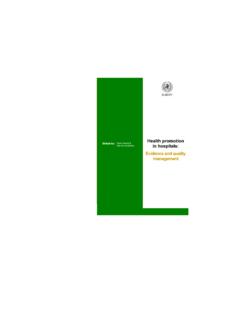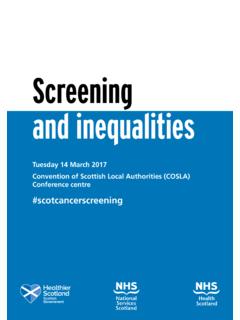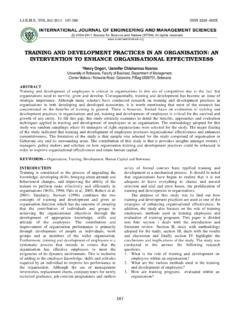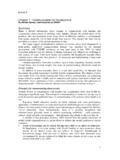Transcription of CARBON MONOXIDE: FROM AWARENESS TO …
1 A report by the All-Party Parliamentary CARBON monoxide GroupBRINGING behavioural insights TO POISONING PREVENTION EFFORTSCARBON monoxide : FROM AWARENESS TO ACTIONC arbon monoxide : From AWARENESS to Action January 2015 This report follows a nine month inquiry Chaired by Baroness Finlay of Llandaff (co-Chair, All-Party Parliamentary CARBON monoxide Group; APPCOG) and Dr Rachel McCloy (University of Reading).On behalf of the inquiry co-Chairs, the report was compiled and written by Dominic Gillan (Researcher and Project Coordinator, APPCOG) and Haley Bowcock (Manager, APPCOG). These individuals work for Policy Connect, a non-profit social enterprise that provides secretariat services to the APPCOG. The work programme of the APPCOG and its secretariat, including the production of this report, is kindly funded by the Council of Gas Detection and Environmental Monitoring, EnergyUK, The Institution of Gas Engineers and Managers, The Gas Industry Safety Group, National Grid Gas Distribution, Northern Gas Networks, SGN, UKLPG, and Wales & West Utilities.
2 This report is not an official publication of the House of Commons or the House of Lords. It has not been approved by either House or its committees. All-Party Groups are informal groups of Members of both Houses with a common interest in particular issues. The views expressed in this Report are those of the Group. Contact the APPCOG secretariat at Policy Connect, CAN Mezzanine, 32-36 Loman Street, London SE1 0EH. CARBON monoxide has a range of sources and exposure environments. Raising AWARENESS in the right ways, relevant to each source and environment, is an important first step towards tackling CO poisoning. - Roland Wessling, Cranfield University45 Foreword 10 Executive Summary 12 Methodology and Steering Group 19 Introduction and Background 21 A New Approach to Preventing CARBON monoxide Poisoning 22 behavioural Theories, Models and Frameworks 23 Inquiry Findings Cross-cutting Lessons and Recommendations 29 What Matters.
3 AWARENESS , Data, Context and Messengers 29 Securing Issue Ownership at Government Level 33 Domestic Appliances and Environments 39 Appliance Use 39 Appliance Servicing 45 Enabling Safe Appliance Behaviours 48 Home Ventilation 52 Detection and Technology 53 The Standard of CARBON monoxide Alarms 54 Acquiring and Installing Alarms 55 Providing and Fitting Alarms 59 Harmonisation of Regulation and Legislation 62 Connected Alarms and Homes 63 Medical and Healthcare Professionals 66 Campsite and Boating Environments 69 Camping 70 Festivals 75 Boating 79 Appendices 82 Glossary and Abbreviations 88 Contributors to the Inquiry 90 About the All-Party Parliamentary CARBON monoxide Group 94 Contents6 Preventing poisoning incidents through a behavioural approach will require focussed and coordinated efforts from a
4 Range of organisations, including charities, government, public sector workers and industry This inquiry has identified three areas of focus Domestic Appliances and Environments Detection and Technology Campsite and Boating Environments8 In addition to this, certain important themes and issues relevant across the sections were identified: 9 AWARENESS -raising matters but as a starting point of a much longer process of behaviour change, Data matters successfully influencing behaviour requires better data than are currently at our disposal, Context matters successful interventions need a sophisticated understanding of people s environment, and, Messengers matter using trusted messengers at the right times, with the right approach, can bring monoxide (chemical formula CO) is a colourless, odourless and poisonous gas produced by the incomplete combustion of CARBON -based fuels.
5 At high concentrations it can kill in minutes, while low concentrations can cause debilitating chronic problems that go undetected and untreated for years. The range of different sources both inside and outside the home, from appliances which burn wood, oil, gas or other fuels, means that tackling the issue as a whole is extremely difficult. By way of example, the final section of this inquiry highlights campsite and boating environments as areas of risk which may not have been considered in the past. Numerous high-profile incidents in recent years, which are covered within this report, have focussed our attention on these hitherto underexplored areas of risk. In 2011, the All-Party Parliamentary CARBON monoxide Group (then the All-Party Parliamentary Gas Safety Group) conducted an inquiry on ways to prevent CO poisoning, including through increased detection, better AWARENESS and improved regulation.
6 The 2011 report has made a real difference in many areas. For instance, a number of important research programmes into the impacts of CO and ways to improve detection have been initiated. Also, Gas Distribution Networks now require their Gas Emergency Service personnel to be equipped with personal CO alarms, which can help them to detect the presence of CO when they enter a potentially dangerous environment. And as we write, we eagerly await the outcomes of a government review into property conditions in privately rented homes, which could lead to mandatory provision of CO alarms in this sector of housing. Importantly, collaboration has greatly improved following recommendations within that report, especially with the creation of the CARBON monoxide All Fuels Action Forum. The Forum s work in bringing together organisations to share best practice and expertise in campaigning, data gathering and research has been highlighted at the national CO conferences organised by IGEM in 2013 and 2014 that were supported by the Forum member Gas Distribution Networks.
7 While this progress should be celebrated, we must never be complacent and there is still a way to go to prevent the unnecessary suffering and cost associated with CO poisoning in the UK. We are unashamedly building into new areas with this report. This inquiry, initiated in April 2014, explores new approaches to tackling CO poisoning, specifically by harnessing behavioural insights and the expertise of academics and industry behavioural professionals. All of those organisations involved in the Forum, and others working to promote CO safety, invest a great deal of resources to prevent poisonings. At a time of squeezed public and private budgets, understanding how to deploy limited resources to the best effect is vital. This inquiry attempts to guide intervention designers to do exactly that. By applying behavioural insights , this inquiry encourages a range of new trials, studies and approaches that should be devised to improve the effectiveness of the push towards raising AWARENESS and helping people keep themselves safe from CO, the silent killer.
8 Foreword11 CARBON monoxide : From AWARENESS to ActionForewordWe hope that this inquiry leads to further and effective action by all of those involved in preventing CO poisoning. Each area, from academic research to industry safety campaigns, and government departmental action in targeting prevention, should be improved and guided by some of those behavioural insights included in this report and elsewhere. Both the requisite understanding and best methods for prevention of CO poisoning are incomplete, and require further collaboration, research and appreciation of the actual scale of this issue. This inquiry highlights where and how this could happen. We would like to thank all of those who generously contributed to the process, through submitting written evidence and data, oral evidence in both group and individual sessions, or through ad-hoc requests. We would also like to thank the rest of the inquiry Advisory Board for their time and contributions.
9 Dr Rachel McCloy Professor the Baroness Finlay of Llandaff Inquiry co-Chair Inquiry co-Chair12 CARBON monoxide (chemical formula CO) poisoning is a serious but preventable cause of death and injury. The central objective of this All-Party Parliamentary CARBON monoxide Group inquiry is to re-focus and improve the important efforts being made to prevent accidental CO poisoning from all fuel sources in the UK. This aim is motivated by a key concern: traditional AWARENESS -raising approaches, although critically important, will on their own likely be insufficient to bring about the key behavioural shifts necessary to prevent CO poisoning in the short and long term. This inquiry therefore seeks to highlight and incorporate relevant insights of behavioural science, to increase the effectiveness of those working hard to prevent CO poisoning insights have been increasingly used by government in recent years to improve the effectiveness of campaigns to encourage better health, more efficient energy use behaviours, and various other initiatives.
10 Principles applied with success elsewhere, such as using trusted messengers and default options , as well as an understanding of the different stages that people go through to establish and maintain certain behaviours, can be readily applied to efforts to promote CO LessonsCarbon monoxide gas can come from many sources and exposure can happen in numerous different environments. This means that there are myriad behaviours to consider when designing interventions to promote CO safety. Furthermore, many preventative behaviours require actions that must be repeated annually, or more frequently, to ensure order to address these issues, this inquiry has identified three areas of focus Domestic Appliances and Environments , Detection and Technology , and Campsite and Boating Environments . In addition to this, certain important themes and issues relevant across the sections were identified: - AWARENESS -raising matters but as a starting point of a much longer process of behaviour change, - Data matters successfully influencing behaviour requires better data than are currently at our disposal, - Context matters successful interventions need a sophisticated understanding of people s environment, and, - Messengers matter using trusted messengers at the right times, and with the right approach, can bring poisoning incidents through a behavioural approach will require focussed and coordinated efforts from a range of organisations, including charities, government, public sector workers and industry bodies.

